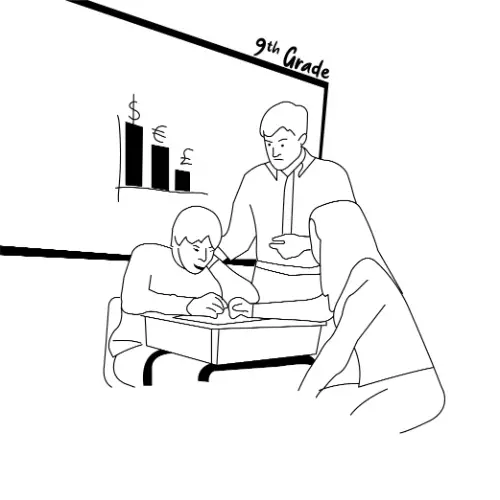Well, teachers and homeschoolers of 9th-grade students, it is official: they have made it to high school. With this significant milestone comes more responsibility, new challenges, and more real-life application of their knowledge, and their money education is no exception. You may struggle with knowing what specific topics they should learn throughout this pivotal year, but fear not. In this guide, we will walk through the primary concepts every 9th-grader should understand, specific ways to approach teaching these topics, and even include a dynamic and effective lesson plan for each category. Whether your instruction begins with elementary economics, banks and banking, investment, budgeting, insurance, or taxation, you can ensure a comprehensive financial curriculum by covering each of these topics. Let’s take a closer look at these ideas so that you can get your students off on the right foot for success in high school and beyond.
National Standards for Personal Finance Education
Download Our Free Teachers' Cheat Sheet
Our free cheat sheet covers every learning objective in the National Standards for Personal Finance Education and the corresponding Kids' Money Lesson Plans - we cover each and every standard!
Basic Economics
Behind every quality financial education is a solid understanding of the basics. Economics is a complex and challenging subject that requires a foundation to move forward and learn well. Teachers can go over foundational economic ideas, including scarcity, supply and demand, decision-making, allocation of goods and services, and the motive of profit. You can get into the factors of production, touching on natural, human, and capital resources, entrepreneurship, and technology. You can expand on students’ understanding of wants and needs, including how these desires affect economic decisions on a personal, local, national, and international level. Many 9th-graders grasp how money works, but you can go deeper into issues like inflation, stagflation, and the role of government in money production and control.
You will see many ways to teach this topic, from textbooks to worksheets to online resources. As you search for your preferred style of instruction, be sure to look for hands-on activities that kids can connect to their lives, showing them how money is and will be an enormous factor in their lives. Some of the ways you can build a sturdy economic base include:
- Have students research a car they would like to buy (have them be realistic - many of us also want a Lamborghini, but they should stick with a reasonable budget). As they go through a shortlist of cars, explain that there is more to it than the sticker price. Some auto parts cost more to import, meaning their foreign car may have unanticipated repair costs down the road, while some companies offer outstanding warranties. Show them that it is always good to do their research with any economic decision, especially the big ones.
9th Grade Lesson Plan #1
Basic Economics
Want to Get All 9th Grade Lesson Plans?
Banks and Banking
No 9th-grade money education would be complete without covering banks and the banking system. Teachers can go over the various types of banks, how they work, and the role of the Federal Reserve and the government in their operation. You can also explain how banking regulations, supervision, and monetary policy affect these financial institutions’ performance. Kids will be interested in the many financial services banks offer, including checking accounts, savings accounts, certificates of deposit (CDs), credit cards, and more. You may go in-depth into things like credit unions versus traditional banks, and the advantages and drawbacks of online banking institutions.
The Federal Reserve Bank has a wealth of resources available, and as a primary operator in the banking system, it is an excellent destination. You will find many activities to hammer home crucial banking points, including:
- · Trace the path of a dollar. Kids can learn what happens to their money after they buy an item. You can find worksheets, online flow charts, and diagrams that students can use to show the path of their cash. You can expand this activity to show how the different branches of banks work together and how the codes and symbols on checks and bills mean specific things. When the activity is finished, they will see the complexity, but also the plain logic, of our money and banking system in the United States.
9th Grade Lesson Plan #2
Banks and Banking
Investment
As your 9th-graders develop and grow their financial education, the idea of investment becomes more prominent. There are many sub-topics to teach in investment, including risk vs. reward, long-term vs. short-term investments, where to put their money, how to diversify in any setting, and the importance of researching statements, holdings, and performance metrics before they invest. Teachers should emphasize how powerful long-term investing can be by showing the effect of compound interest over many years.
You can engage your students in multiple ways around this topic. The choices are limitless, but you can focus on the lessons you think are the most critical for your group of scholars to learn, including:
- Students complete mock portfolio projects. To narrow down the vast choice of publicly traded stocks, give them a pre-selected set of companies to choose from and build their portfolios. Have them analyze past stock prices to see if the investment is a historically good performer and estimate future growth using essential company data. Show them how to select between a mix of tried and true blue-chip companies, hot new tech stocks, and value stocks that combine steady growth and consistent performance.
9th Grade Lesson Plan #3
Investment
Budgeting
Many high school students begin to get jobs or plan to get employment after graduation. A significant piece of this transition period is managing a budget. Teachers will help students greatly if they demonstrate how to create and manage a realistic and accurate plan broken down into categories. You can show them how to take care of their needs first and then see how much they have left to spend on wants or savings while staying within their means. Explain that they can make adjustments to their budgets so that they can adjust in the next month if they spend too much in one area.
Budgets are an excellent tool for students and adults alike, and including kids in real-life budgeting activities is a surefire way to get them on track for financial success. Teachers can help their kids reach their goals by:
- Have students use their projected financial information to create a personal budget. They can research what typical high school-level jobs pay, using that data to develop accurate income numbers and budget for the month. Make sure they include the costs of going out to eat, gas (when they get old enough to drive), and other expenses like entertainment. They will see how critical it is to plan for every expense and income stream so their budgets stay on track.
9th Grade Lesson Plan #4
Budgeting
Insurance
As your class of 9th-graders continues on its economic journey, they will see the value of managing risk. One primary way to protect your investments and minimize losses is through insurance. Educators can explain that insurance costs money to have but will help cover costs if things go south. You could show them the many insurance products in areas such as fire, health, flood, automobile, and home, and how you can purchase various levels of protection depending on your budget and risk allowance.
Insurance is a crucial part of money management, and teachers can approach this topic from many different angles. You can have your group of 9th-graders:
- Research different types of insurance, focusing on a specific one like car insurance. They will learn the types of insurance and notice that premiums increase the more you protect your vehicle, while other factors influence the price you will pay, such as your gender, age, and driving history. They can estimate how much they may pay in insurance for their vehicle, adding the costs to their monthly budgets. Students will also see the benefits of this protection, giving them decreased repair bills or even paying for damages.
9th Grade Lesson Plan #5
Insurance
Taxation
Another topic that 9th-grade teachers can go over with their students is the concept of taxation. This idea is a fact of life and affects every component of money, from spending to saving to investing. Teachers can show students that many purchases include sales taxes, their paycheck will get hit with income taxes, and they will pay taxes on properties they own in the future. There are benefits to taxes, too, and you can explain how these monies help fund public services like fire and police departments, schools, roads, and bridges.
You can develop many different ways to teach taxation, including online resources that focus on how taxes impact various groups of people. You can:
- Show students the impact of taxes on their financial future. Have them research a career choice and its corresponding salary, determining which tax bracket it would put them in and how much it would affect their take-home pay, both annually and monthly. Guide them to show them how to plan accordingly, always including taxes in their budgets and when they plan to purchase any items.


